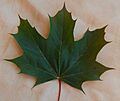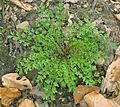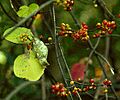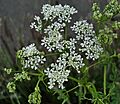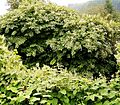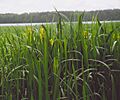List of invasive plant species in Maryland facts for kids
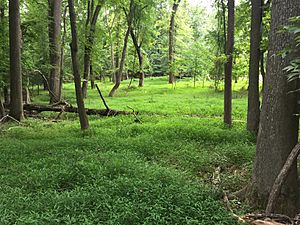
Many plants that are not originally from Maryland have been brought here. Some of these plants have become "invasive species." This means they spread quickly and cause harm to the environment. They can push out native plants, which are the plants that naturally grow in Maryland. This article will tell you about some of these non-native invasive plants found in Maryland.
Contents
What are Invasive Plants?
Invasive plants are like uninvited guests who take over a party! They are plants that did not originally grow in a certain area. When they are brought to a new place, they can spread very fast. They often grow better than the plants that are supposed to be there. This is because they don't have their natural enemies, like insects or diseases, in the new environment.
How Do They Get Here?
Many invasive plants were brought to Maryland on purpose. People thought they looked pretty or would be useful. For example, some were planted in gardens or used to control soil erosion. Others arrived by accident. Their seeds might have traveled on cars, boats, or even in soil. Once they are here, they can spread quickly through seeds, roots, or even small pieces of the plant.
Why Are They a Problem?
Invasive plants cause big problems for Maryland's natural areas.
- They harm native plants: Invasive plants grow fast and take up all the sunlight, water, and nutrients. This leaves less for the native plants, which can't compete.
- They hurt wildlife: Native animals, like birds and insects, depend on native plants for food and shelter. When invasive plants take over, animals lose their homes and food sources.
- They change ecosystems: An ecosystem is a community of living things and their environment. Invasive plants can change the soil, water, and even how fires spread. This can damage the whole ecosystem.
Common Invasive Plants in Maryland
Maryland has many invasive plants. Here are a few examples of plants that cause big problems.
Japanese Stiltgrass
Japanese stiltgrass (Microstegium vimineum) is a grass that grows very quickly. It forms thick mats on the forest floor. This stops native plants from growing. It can spread easily because its seeds are carried by water, animals, and even people's shoes.
Tree of Heaven
The Tree of Heaven (Ailanthus altissima) is a fast-growing tree from Asia. It can grow almost anywhere, even in cracks in sidewalks! It releases chemicals from its roots that stop other plants from growing nearby. This tree is very hard to get rid of once it takes root.
Japanese Honeysuckle
Japanese honeysuckle (Lonicera japonica) is a vine that climbs over other plants and trees. It can cover them so much that they don't get enough sunlight and die. It also smells sweet, which might make people think it's harmless, but it's a big problem for native forests.
English Ivy
English ivy (Hedera helix) is another climbing vine. People often plant it in gardens. But it can escape and climb up trees, covering them completely. This makes trees weak and can even cause them to fall over. It also forms a dense carpet on the ground, preventing other plants from growing.
Kudzu
Kudzu (Pueraria montana var. lobata) is sometimes called "the vine that ate the South." It grows incredibly fast, sometimes a foot a day! It covers everything in its path, including trees, buildings, and signs. It smothers native plants and changes the landscape.
Aquatic Invasive Plants
Invasive plants don't just grow on land. Some also cause problems in Maryland's rivers, lakes, and ponds.
Hydrilla
Hydrilla (Hydrilla verticillata) is a submerged plant. This means it grows entirely underwater. It forms thick mats just below the surface of the water. These mats can block sunlight for other underwater plants. They also make it hard for boats to move and for fish to swim.
Water Hyacinth
Water hyacinth (Eichhornia crassipes) floats on the surface of the water. It has beautiful purple flowers, but it's a big problem. It can cover entire waterways, blocking sunlight and oxygen for aquatic life. This can harm fish and other animals living in the water.
What Can Be Done?
Controlling invasive plants is a big job. People are working to remove them and plant native species instead. You can help too!
- Learn about native plants: Choose native plants for your garden instead of non-native ones.
- Don't spread seeds: Clean your shoes, bikes, and pets after being in natural areas to avoid spreading seeds.
- Report new invaders: If you see a plant you think might be invasive, you can report it to local park rangers or environmental groups.
By understanding and acting, we can help protect Maryland's beautiful natural environment from these plant invaders!
Images for kids
-
Alternanthera philoxeroides.jpg
Alligator weed
-
Didymosphenia geminata.jpg
Didymo, Rock Snot
-
Egeria densa.jpg
Brazilian Waterweed
-
Hydrilla verticillata.jpg
Hydrilla
-
Iris pseudacorus.jpg
Yellow iris
-
Myriophyllum aquaticum.jpg
Parrot Feather
-
Myriophyllum spicatum.jpg
Eurasian Water-Milfoil
-
Potamogeton crispus.jpg
Curly Leaved Pondweed
-
Prymnesium parvum.jpg
Golden Algae
-
Trapa natans.jpg
Water Chestnut
See also
- Invasive species in the United States


